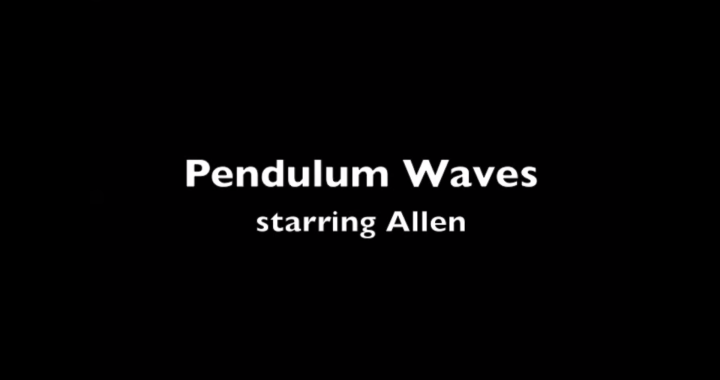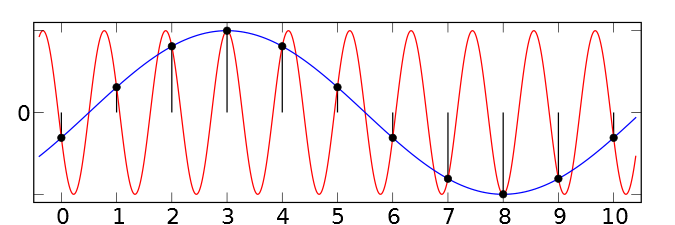Within the last days a couple of amazing physics videos have been passed along on Twitter. My personal favorites are the two I want to talk about now. They basically involve some sort of experiment with oscillation or wave-like motion, with a twist. But see the first video for yourself:
Coupled pendulums
https://www.youtube.com/watch?v=kqFc4wriBvE
Personally I find it amazing. 32 metronomes start out completely independent on a moving table and they gradually align!
First of all the choice of colors is very beautiful but has no effect on the experiment, however, the weight of the metronomes are approximately set to match the same speed. The weight on a metronome determines the vibration period by the inertia set on the lever. This or a multiple of the base inertia is necessary to make this experiment work.
Why do they line up?
The metronomes are on a moving table and therefore can be viewed as a coupled system. Every metronome exerts a force on the moving table and opposing forces cancel out. With 2^5 metronomes you can be certain that at some point of time some metronomes will exert a force into one direction that is stronger than the opposing force, slightly moving the table to that side. Now this is where the coupling really comes into effect. When the table moves the period of the pendulum in direction of the movement of the table will be reduced, forcing the pendulum to swing to the opposite direction faster. On the other side (literally) the pendulum motion will be elongated, extending the movement in that direction. So in this exact moment the metronomes started to align just a little bit. Of course in the very next moment a couple of the other metronomes might exert just a different force which makes the entire process quite complicated. However, if we wait long enough the resonance of these pendulums will cause the metronomes to line up. Amazing right?
Now take another look, they line up pretty quickly for such a bulk of different complicated forces influencing each other, however at?2:11?You see something interesting happening. Far on the right in the pink row, the second metronome from the front, is aligned, but exactly opposite to the other metronomes. You can hear, it’s lined up by listening to the sound of the metronomes. This is quite interesting because it takes quite some time for the last one to line up and this is because the counterweight is in sync with the movement of the table. Eventually it will line up because ?the metronomes are attenuated and once the metronome is just slightly getting out of sync the table movement will force the last metronome to line up.
Why do you care, you’re a geophysicist?!
First of all, they’re colorful and cool and those metronomes are pretty mesmerizing.
Those metronomes are reminding me a lot of geophones. The good ol’ mechanic geophones work with a spring and a weight and hopefully some kind of attenuation. Those geophones are put on a moving “table” aka the ground and you measure the force exerted on them and every time a new movement comes in, the spring and weight in the geophone are affected again. Now I was talking about attenuation and there is a reason for it. Without attenuation the forces on the metronomes and the forces on the spring and weight would sometimes build up without any counterweight stopping the motion, which would result in a lot of broken geophones or quite some pendulums ripped off of metronomes.
Uncoupled pendulums
I told you there was a second awesome video. Well this is just beautiful. Fifteen weights on a string with linearly increasing length:
Those are some pretty movements, right?
Well definitely and those weights are not coupled in any way. Just because those strings are incresing in length, we see some interesting patterns. But how?
Well first we have those 15 weights moving independently moving into a wave-like formation of two extrema (one left – one right) and a point of inflection in the middle. We clearly see how those extrema get more, the longer those weights swing freely. ?At 00:35 there are already four points of inflection in the middle. Two seconds later you can see five points of inflection and then it becomes really interesting. In signal theory we have to be very careful with our waves. Basically, we have to know two values of our wave to be able, to know how our wave looks like. Technically, you can say we need to at least know two values for the highest frequency of our wave. To make it a bit easier we will look at this very convincing sin-wave which only leaves us with one frequency:
Now you see, when we don’t get two values for every wave here, we reconstruct a wave with a lower frequency (in blue). This reconstruction of wrong waves is called aliasing.
Going back to the wave of weights, you may recall me telling you about 5 points of inflection. This leaves us with 10 weights to swing at our extrema of the wave. Two for every wave right? Right! So we’re fine. But the video doesn’t stop here, see what happens next:
Aliasing!
Exactly! Going on from there, we don’t have enough weights to “reconstruct” a wave of 15 weights and the patterns get funny. First you see “strings of three” that swing independently. It goes on to “three independent waves” of five weights each, which are my personal favorites. Afterward, it goes on to two waves ? 7 and 8 weights. Those patterns go on a while and are pretty amazing, right? Well, just imagine that a couple thousand of weights are swinging like that and form funny patterns. This is probably pretty cool, if you’re putting it on Youtube. Once we’re talking about seismic data we have quite a few “weights” (we call them samples), that are supposed to give us the opportunity to reconstruct the real wave signal from the underground. If we get aliasing in a couple thousand points, you can only imagine the funny patterns that will never in life give us the opportunity to get our data back. In the face of the cost of seismic acquisition, you might consider just how important it is to get it right the first time.
The curse of creative geophysicists
So if you haven’t noticed yet, the curse of a creative geophysicist is, seeing just that bit geophysics too much in things. However, if you liked it, leave a note and let me know.?
Jesper Dramsch
Latest posts by Jesper Dramsch (see all)
- Juneteenth 2020 - 2020-06-19
- All About Dashboards – Friday Faves - 2020-05-22
- Keeping Busy – Friday Faves - 2020-04-24




I like it, even if I don’t understand everything of what you were talking about.
First off, in case you don’t already know, a meormnote is a nifty little device that sets a straight tempo to a click or a tick-tock. The picture on the left is an old-school meormnote. Now days you can get an electronic meormnote that looks just like guitar tuner. In fact, there are some guitars tuners that have built in meormnotes.
I love this blog, always great content